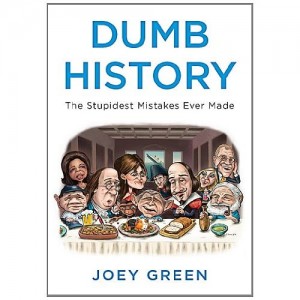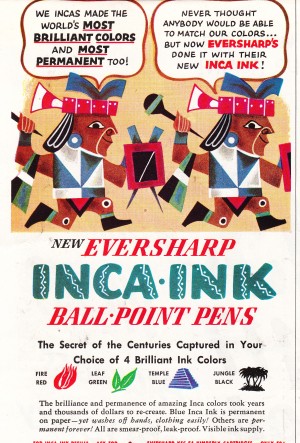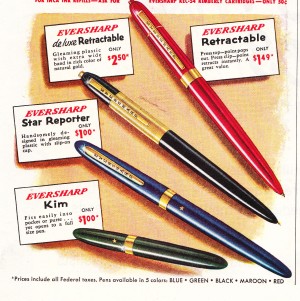History
Dumb History

Just got my copy of this title, and it looks like a winner for all WU-vies. I'll report more soon.
Posted By: Paul - Sun Mar 18, 2012 -
Comments (4)
Category: History, Stupidity, Weird Studies and Guides, Books
Weird Science – Watch and Learn

Outside it is not much to look at, little more than a discoloured rock dredged up from the sea floor. But an x-ray scan of the object, actually a pocket watch recovered from a 17th century shipwreck, has revealed that the internal mechanism has been perfectly preserved. The computer aided tomography system used was sensitive enough to pick out the tiniest details, included the engraved name of the master watchmaker, one Niccholas Higginson of Westminster, London (Gizmodo).
As if more proof were needed that they don’t build them like they used to, a UK group has started collecting donations to build the first fully working version of Babbage’s “Analytical Engine”. The original design, dating from 1837, was never completed, possibly due to a combination of the strict engineering tolerances needed and Babbage’s notoriously prickly temperament. If the final machine works as advertised, it will be very strong confirmation of the claim that Babbage designed the first general purpose, programmable computer (BBC News).
Meanwhile, in Slovenia, Borut Povse and his team are busy teaching a modern descendant of Babbage’s design to hit people. Somehow Povse has convinced six volunteers to let an industrial robot hit them on the arm with various sharp or blunt implements in an effort to determine how much pain each blow causes. Obviously this has a beneficial use in that robots can be programmed not to exceed certain levels of force near a human obstacle, but will also be of immense interest to the machines during any future robot uprising (New Scientist).
Another robot out to supplant humans is HRP-4, a gynoid (female android), that has learnt to sing by copying the inflection and expressions of a human performer, right down to the breathing. The hope is to make robots behave in a more convincingly natural way, and so overcome the so called ‘uncanny valley’. From the video, it looks like they’ve still got a way to go (Daily Mail).
More in extended >>
Posted By: Dumbfounded - Fri Oct 22, 2010 -
Comments (5)
Category: Anthropomorphism, Beauty, Ugliness and Other Aesthetic Issues, Charities and Philanthropy, Futurism, History, Archaeology, Injuries, NGOs, Robots, Science, Technology
Ghost Story Comes To Life

Posted By: Nethie - Fri Aug 27, 2010 -
Comments (4)
Category: Accidents, Daredevils, Stuntpeople and Thrillseekers, Death, Disasters, History
Station Wagon or Limousine?

Posted By: Nethie - Sun Aug 22, 2010 -
Comments (9)
Category: History, Mass Transit, Motor Vehicles, Cars, Transportation, 1960s
Big Bang Big Boom
BIG BANG BIG BOOM - the new wall-painted animation by BLU from blu on Vimeo.
Posted By: Paul - Wed Jul 07, 2010 -
Comments (4)
Category: History, Stop-motion Animation
A Little Light Weirdness – 7

Mind you, Mr. Brown is not the only statesman trying to avert a bleak future this week, an unnamed Arab ambassador got the shock of his life when he finally lifted his new bride’s niqab, only to find she had cross-eyes and a beard. The groom immediately went to court to have the marriage annulled, claiming he had been tricked into the marriage and that the bride’s parents had used pictures of her attractive older sister to deceive him. The court found for the groom and dissolved the marriage, but turned down his demand for $150000 compensation (Daily Mail).
But perhaps he’s been a bit quick to judge by appearances. Two Chinese men certainly were when the found a hoard of 20 clay artefacts in an old tomb they discovered in a field near their home, only to later sell the whole lot to a collector for less than $2000. Unfortunately for the pair, theirs were rare finds from the Sui-Tang Dynasty, making the collection over 1000 years old. One item alone, a pottery figurine, recently reached $150,000 at auction (Daily Times).
More fortunate was Wendy Jones of Aberglasney in Wales, who took the old plate she’d had perched on her sideboard for years – except on those odd occasions it had fallen off it - to a TV antiques show, in a plastic carrier bag, only to be told it was part of a rare, Prussian royal service worth over £100000 (Telegraph).
More in extended >>
Posted By: Dumbfounded - Wed Feb 10, 2010 -
Comments (3)
Category: Boats, Cops, Crime, Stupid Criminals, Food, Government, Officials, History, Obscenity, Pirates, Politics, Retail Establishments, Theater and Stage, Facial Hair, Goofs and Screw-ups
Follies of the Mad Men #76
[From The Saturday Evening Post for October 10 1953. Two scans, top and bottom.]
Nothing like aligning your product with a civilization that practiced human sacrifice. The Incas weren't the Aztecs, but as Wikipedia reminds us: "There is [sic] archaeological discoveries supporting the presence of sacrifice within Inca society according to Reinhard and Ceruti: 'Archaeological evidence found on distant mountain summits has established that the burial of offerings was a common practice among the Incas and that human sacrifice took place at several of the sites.The excellent preservation of the bodies and other material in the cold and dry environment of the high Andes provides revealing details about the rituals that were performed at these ceremonial complexes.'"
And did they actually make the best ink ever? I can't find any reference to such an accomplishment.
Posted By: Paul - Tue Nov 10, 2009 -
Comments (3)
Category: Business, Advertising, Products, History, Archaeology, 1950s, South America
Hair Dress Through the Ages
Posted By: Paul - Fri Oct 16, 2009 -
Comments (2)
Category: History, Hair Styling, 1950s
Max Fleischer’s News Sketches
Was this one of Chuck's inspirations for NEWS OF THE WEIRD...?
Posted By: Paul - Sat Aug 08, 2009 -
Comments (3)
Category: Art, History, Cartoons, 1940s, Yesterday’s Tomorrows
Chocolate Just Got Better!

FYI: Chocolate was, as everyone knows, invented/discovered by the Aztecs. But what is less well known is that they did so at least 3000 years ago, and were probably trying to make beer. Anthropologists John Henderson, of Cornell University, and Rosemary Joyce, of University of California, discovered cacao residues on pottery vessels dating back to 1000 BCE that are believed to be from a drink formed by fermenting the pulp and seeds (PNAS).
(Image by Wikipedia.)
Posted By: Dumbfounded - Fri Jul 17, 2009 -
Comments (20)
Category: Food, Candy, Nutrition, History, Archaeology, Products

| Who We Are |
|---|
| Alex Boese Alex is the creator and curator of the Museum of Hoaxes. He's also the author of various weird, non-fiction, science-themed books such as Elephants on Acid and Psychedelic Apes. Paul Di Filippo Paul has been paid to put weird ideas into fictional form for over thirty years, in his career as a noted science fiction writer. He has recently begun blogging on many curious topics with three fellow writers at The Inferior 4+1. Contact Us |






